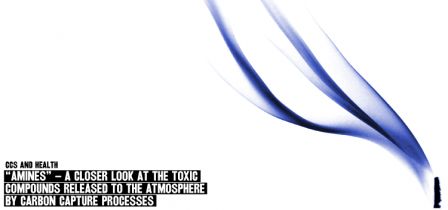"CCS and Health | “ Amines ” - A Closer Look at the Toxic Compounds Released to the Atmosphere by Carbon Capture Processes
"Leading technologies for CO2 capture systems - on fossil-fuelled power plants and other CO2-emitting facilities - involve the use of so called amines. These compounds are used to separate the CO2 from the flue gas. Most of the amines are recycled after the capturing process, but a part of the amines will be released into the environment - one million tonnes of captured CO2, will emit up to 160 tonnes of amines.
Scientists have limited knowledge about the toxicity of these amines and the reactions when they are released at an extensive scale such as by a fossil-fuelled power plant, but it is well-known that the released amines degrade into highly toxic compounds that may cause adverse health effects and environmental damage. One of the compounds, Nitrosamines, is considered to be one of the most potent carcinogens in tobacco smoke.
In the beginning of May 2010 the Norwegian government decided to postpone the construction of the CCS-plant at Mongstad link. Contributing to the postponement were fears of the release of carcinogenic compounds - amines - associated with the CCS-process.
(...) The amine compounds are emitted during the CO2 capture process. Most of the amines will be recycled inside the plant, but a small fraction of amines will be released to the atmosphere together with the cleaned exhaust gas. The amine emissions can be contained in water droplets, be fresh liquid droplets and in the form of gas. Some of the emitted amines are non-toxic, and some are toxic. The latter will have a negative environmental impact both directly and indirectly through degradation (atmospheric oxidation) into other compounds in the atmosphere.
Effects on the environment
The released amines will not only potentially cause health effects like mutations, cancer and birth defects on humans; they will also have a toxic influence on vegetation, soil, fauna, the aquatic life and ecosystems. So far researches lack deeper knowledge on how the amines will react when they are released in the way and at the amount which is the case with large-scale CO2 capture plants. If the compounds are unstable they may transform into new substances. If the compounds are stable they may have a long residence time.
One million tonnes CO2 captured = 40 to 160 tonnes of amines released to the atmosphere
Even if the released amine compounds are a small fraction of the amines used in the process, the absolute amount depends on the size of the plant and will be a lot if the CO2-capturing process is extensive. Which is the case with fossil-fired power plants. "
20/05/2010 - Lien vers article en ligne
.
RELATIF A CET ARTICLE : "Pariant sur l'augmentation du coût des émissions, Alstom cherche à commercialiser une solution complète de captage et stockage de CO2 d'ici à 2015, avec une technique à base d' ammoniaque réfrigéré. " Cliquez ici pour lire l'article

Commentaires
Very interesting, I don't think the health of the people is the most important thing here, most of this is political and financial. That is the sad reality.
health articles